Homemade Sugar-Free Refrigerator Dill Pickles: Easy & Healthy No-Cook Recipe
Discover the simplest way to enjoy crisp, tangy pickles with our recipe for refrigerator dill pickles (no sugar). Perfect for anyone seeking a quick pickling method that is entirely sugar-free, this recipe involves minimal effort. You’ll simply combine your freshly sliced cucumbers and onions with aromatic spices, pour over a simple brine, and let the magic happen in your fridge. This versatile recipe also includes an option for a pickle recipe without dill, making it adaptable to various tastes and dietary needs. Both variations are ideal for those following low-carb, keto, gluten-free, or vegan lifestyles.
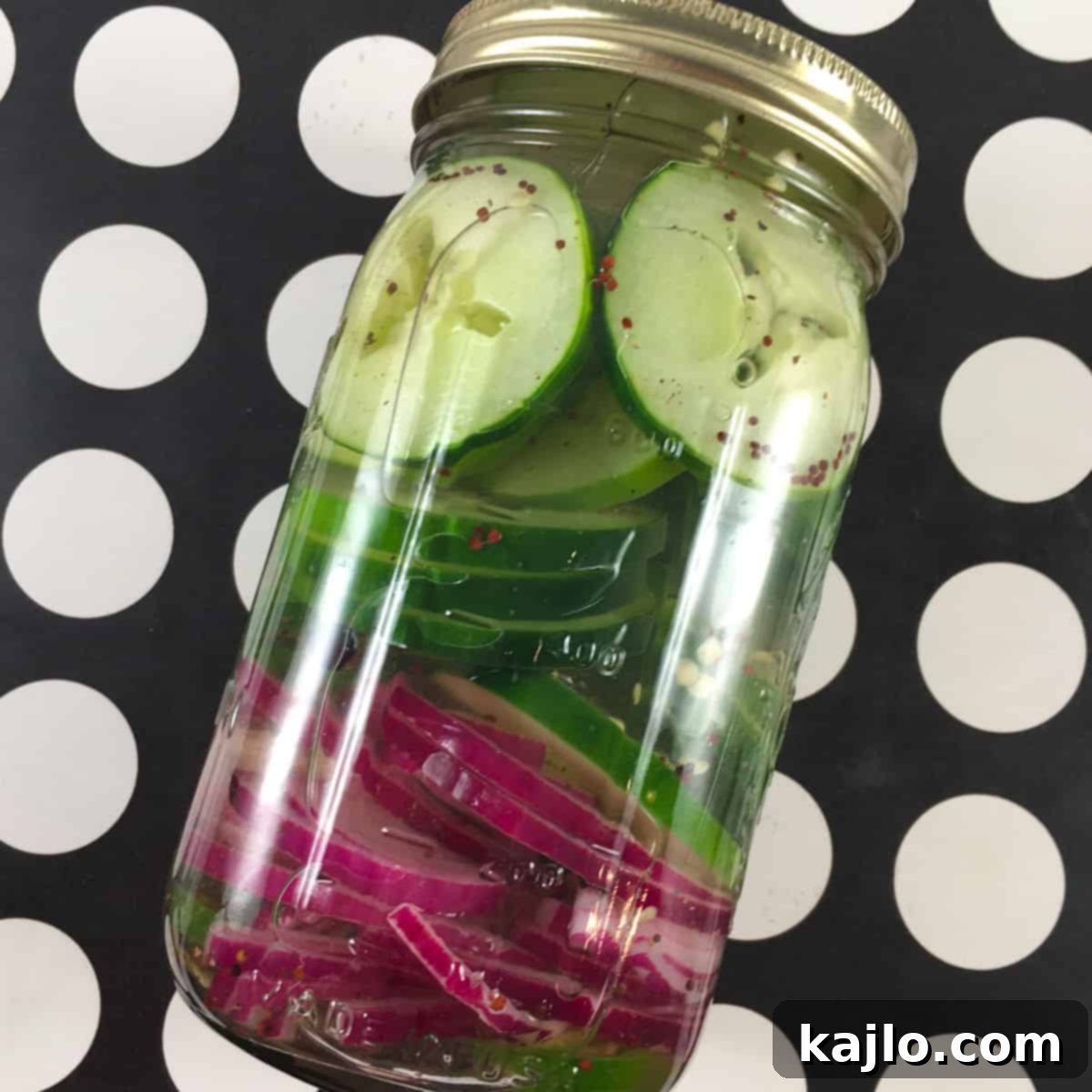
Why Choose No-Cook Refrigerator Pickles?
If you’ve never ventured into making no-cook refrigerator pickles before, now is the perfect opportunity. Especially if you cultivate your own produce, these refrigerator pickles without sugar offer an excellent way to utilize an abundance of garden cucumbers as the season draws to a close. Beyond preserving your harvest, these pickles are a fantastic addition to any meal.
These old-fashioned cucumbers and onions in vinegar are a delightful topping for burgers and sandwiches, a zesty addition to salads, or a refreshingly simple snack on their own. You’ll undoubtedly appreciate this recipe for sugar-free refrigerator pickles for its sheer ease and convenience, requiring no boiling or complex canning procedures. It’s the ultimate no-boil pickles solution for busy kitchens. (Don’t miss our comprehensive tips on how you can adapt this method to create both sweet and spicy pickles too!)
🥒 Classic Refrigerator Dill Pickles (No Sugar)
Crafting the best sugar-free refrigerator dill pickles begins with a few simple, fresh ingredients:
Ingredients for Dill Pickles:
- 10 ounces pickling cucumbers, thinly sliced (approximately 284 grams; 1-2 medium cucumbers)
- 2-3 cloves garlic, smashed (for a pungent, savory depth)
- ½ medium onion, thinly sliced (red onions are recommended for color and mildness)
- 4 fresh dill sprigs (the heart of the dill pickle flavor)
- 1 cup white vinegar (the foundation of our tangy brine)
- 3 cups water (preferably very hot from the tap, to help dissolve salt)
- 1½ tablespoons finely ground sea salt (essential for flavor and preservation)
You’ll find a printable version of this recipe at the end of this guide.
Choosing Your Ingredients Wisely
While fresh dill is preferred for its vibrant appearance and less tendency to cling to the cucumbers, dried dill can certainly be used for these no-cook dill pickles. If opting for dried dill, a general guideline is to substitute about 1 tablespoon for the fresh sprigs.
The type of cucumber is crucial for optimal pickle texture. Pickling varieties, such as Kirby cucumbers, are highly recommended due to their firm texture and ability to absorb the brine well. Smaller Persian (mini) cucumbers may not soften as effectively and are generally not ideal for this sliced pickle recipe, though they might work for pickle spears. English cucumbers, with their thinner skins and higher water content, can result in a softer, potentially soggy pickle texture, as noted by culinary experts (source). For best results, stick with pickling cucumbers.
For the onion component, red onions are a favorite choice in this recipe. They impart a beautiful light pink hue to the brine and offer a slightly milder flavor compared to yellow onions. If you prefer to avoid the pink tint, or simply enjoy a sweeter profile, sweet onions are a delightful alternative.
When it comes to vinegar, basic white vinegar is an excellent, economical choice with a neutral flavor profile that allows the other spices to shine. However, feel free to experiment with other vinegars such as white wine vinegar, red wine vinegar, apple cider vinegar, or even rice vinegar to impart different subtle notes to your pickles.
Does the type of salt matter when making pickles? Absolutely. For traditional canned pickles, canning salt is specifically formulated to prevent clouding and ensure proper preservation. For refrigerator pickle recipes, however, the requirements are less stringent. Fine-ground sea salt or Kosher salt are perfectly suitable and will yield excellent results, contributing to both flavor and the pickling process.
The essential kitchen equipment for these no-cook refrigerated pickles includes a wide-mouth quart jar with a lid, ideally a glass mason jar, to provide ample space for ingredients and brine. You will also need a sharp knife or a mandoline slicer to achieve uniformly thin slices for your vegetables, which is key for quick pickling.
🌶️ Zesty Refrigerator Pickles without Dill
If dill isn’t to your taste, or you’re simply looking to explore different flavor profiles, you can easily make these homemade refrigerator pickles without it. This variation offers a spicier, more aromatic pickle experience. Here’s what you’ll need for this exciting alternative:
Ingredients for Dill-Free Pickles:
- 10 ounces pickling cucumbers, thinly sliced (284 grams; 1-2 cucumbers)
- 2-3 cloves garlic, smashed
- ½ medium red onion, thinly sliced
- ½ jalapeno, sliced (for a pleasant kick)
- 1 teaspoon brown mustard seeds (adds a pungent, earthy note)
- 1 teaspoon juniper berries (contributes a piney, slightly citrusy aroma)
- ½ teaspoon black pepper (for a subtle warmth)
- 1 bay leaf (for an herbaceous undertone)
- 1 cup white vinegar
- 3 cups water (very hot from tap)
- 1½ tablespoons finely ground sea salt
Feel free to get creative with the herbs and spices in this recipe. Juniper berries can be omitted if unavailable, or you could add coriander seeds, red pepper flakes for extra heat, or even a touch of turmeric for color and earthy flavor. Customization is key to making these pickles truly your own!
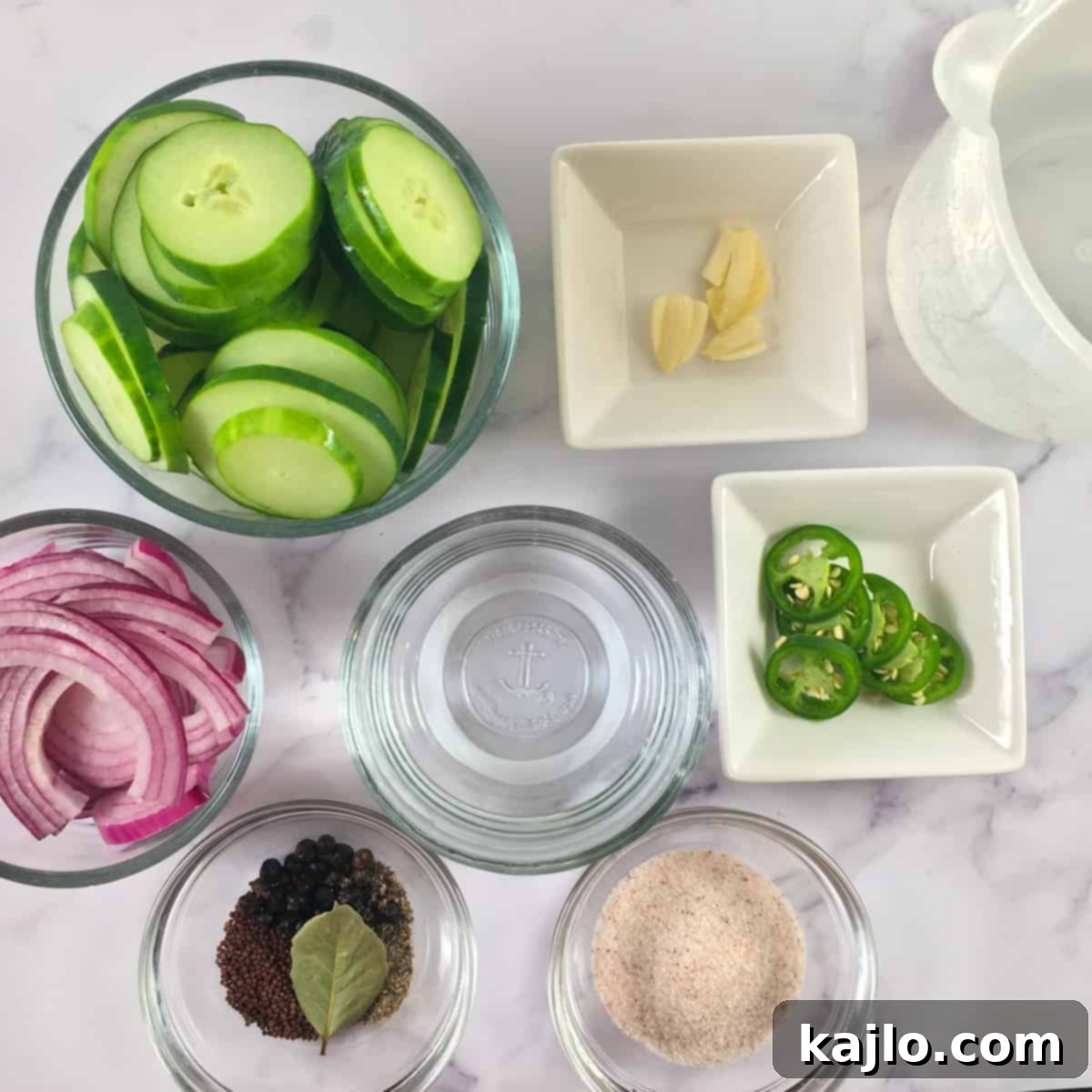
➕ Step-by-Step: How to Make Refrigerator Pickles (No Sugar)
Making delicious sugar-free fridge pickles is incredibly straightforward. Follow these detailed steps for perfect results every time:
Prepare the Vegetables: For this no-cook recipe, it’s crucial to slice your vegetables thinly to allow the brine to penetrate quickly and evenly. Do not use whole cucumbers; they would take far too long to pickle. Slice the pickling cucumbers into ¼-inch (0.6 cm) thick rounds, discarding the stem end. Next, cut the onion in half and slice it into delicate ⅛-inch (0.3 cm) thick pieces. Finally, smash the garlic cloves slightly to release their aromatic oils.
Mix the Brine: In a separate bowl or measuring cup, combine the white vinegar, hot water (the heat helps dissolve the salt faster), and finely ground sea salt. Stir thoroughly until the salt is completely dissolved and the mixture is clear. Set this brine aside while you arrange your vegetables.
Layer the Jar: Begin layering all your prepared vegetables, herbs, and spices into a clean wide-mouth quart jar. A good strategy is to start with a layer of herbs and spices at the bottom, then alternate layers of cucumbers and onions, ensuring even distribution of flavors. Finishing with cucumbers on top can sometimes help keep the herbs submerged.
Add the Brine: Carefully pour the prepared brine over the ingredients in the jar. Fill the jar until the brine reaches the bottom of its neck, ensuring all the cucumbers and other ingredients are fully submerged. You likely won’t use all of the brine; simply discard any excess. Leave approximately 1-inch (2.54 cm) of headspace at the top of the jar. This space is important, as it allows for gentle shaking and prevents overflow if the vegetables expand slightly. If you’ve overpacked the jar, you may need to remove a few vegetable slices, but this is rarely necessary if sliced correctly.
Refrigerate and Enjoy: Securely put the lid on the jar. Give it a gentle shake to distribute the brine and ingredients, then place it in the refrigerator. While these quick pickles can be sampled in as little as 3-5 days if impatience strikes, they truly reach their peak flavor and crispness after sitting in the fridge for about a week. Although they are “quick” pickles, allowing them time to meld flavors makes them a rewarding “slow food” experience. These vibrant pickle chips are fantastic on sandwiches, wraps, or as a bright side to any meal!
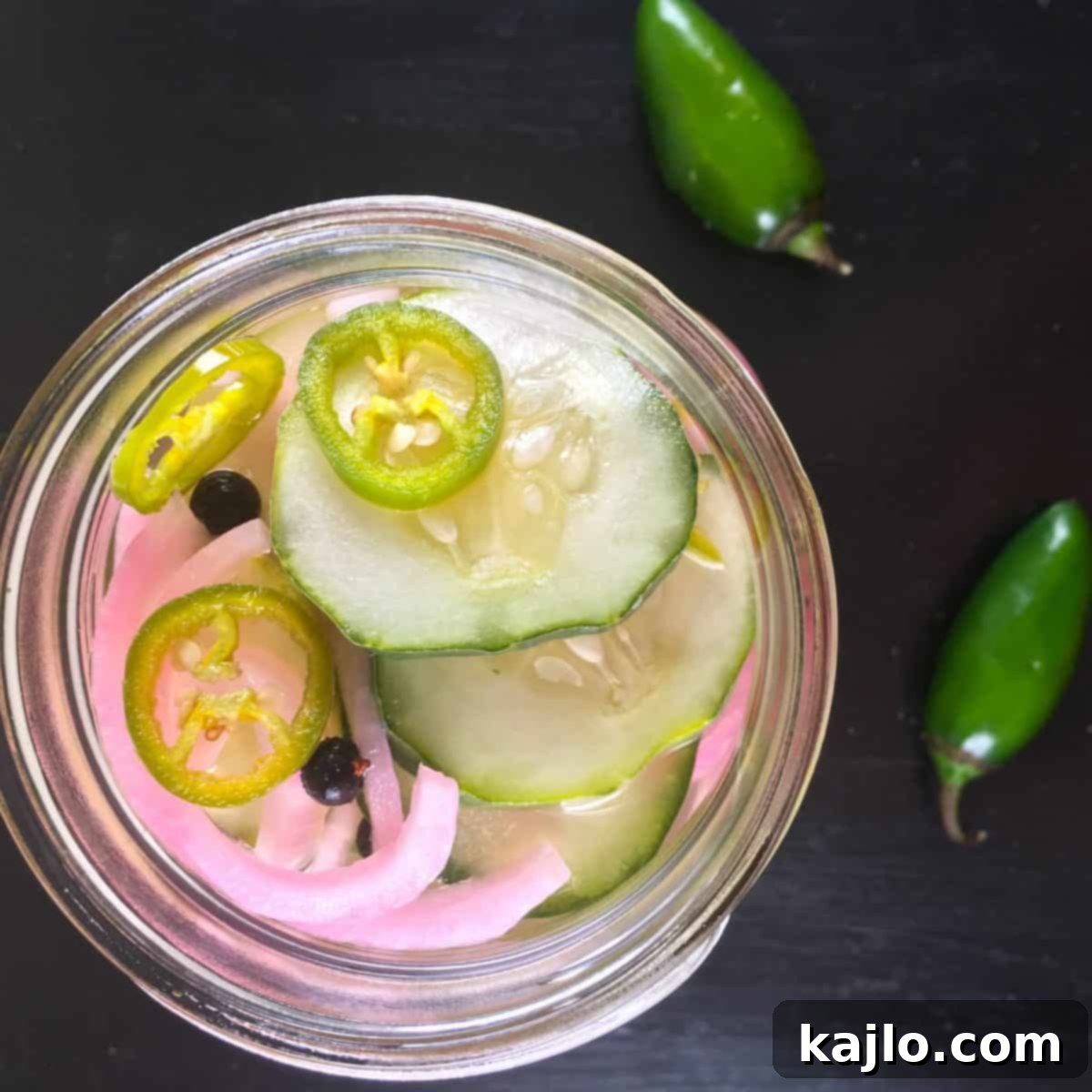
⭐ Refrigerator Pickles vs. Traditional Pickling: What’s the Difference?
The primary distinction between old-fashioned refrigerator pickles and classic, shelf-stable pickles lies in their preservation method. Fridge pickles, as their name suggests, are not canned or heat-processed in a way that creates a vacuum seal for long-term shelf storage. Instead, they rely solely on refrigeration to stay fresh. This means that while properly canned pickles can be safely stored at a cool room temperature for many months, fridge pickles are perishable and must be kept in the refrigerator.
Furthermore, these low-sugar refrigerator pickles have a shorter shelf life, typically lasting about 3-4 weeks when continuously refrigerated and submerged in brine. For safety, this recipe, with its 1:3 vinegar-to-water ratio, is designed exclusively for refrigerator storage and is **not safe for canning**. Cucumber pickle recipes intended for heat processing and shelf-stability require a significantly higher acidity level to prevent spoilage.
“Traditional pickles” can also often refer to fermented cucumbers, where beneficial bacteria are encouraged to thrive. This fermentation process produces lactic acid, giving the pickles their distinct sour or tangy flavor and acting as a natural preservative. The downside of traditional ferments is their time-consuming nature, often taking weeks to complete. Our pickled cucumber recipe offers a convenient shortcut: the vinegar brine provides that desirable piquant flavor without the lengthy fermentation process, allowing you to enjoy homemade pickles much faster.
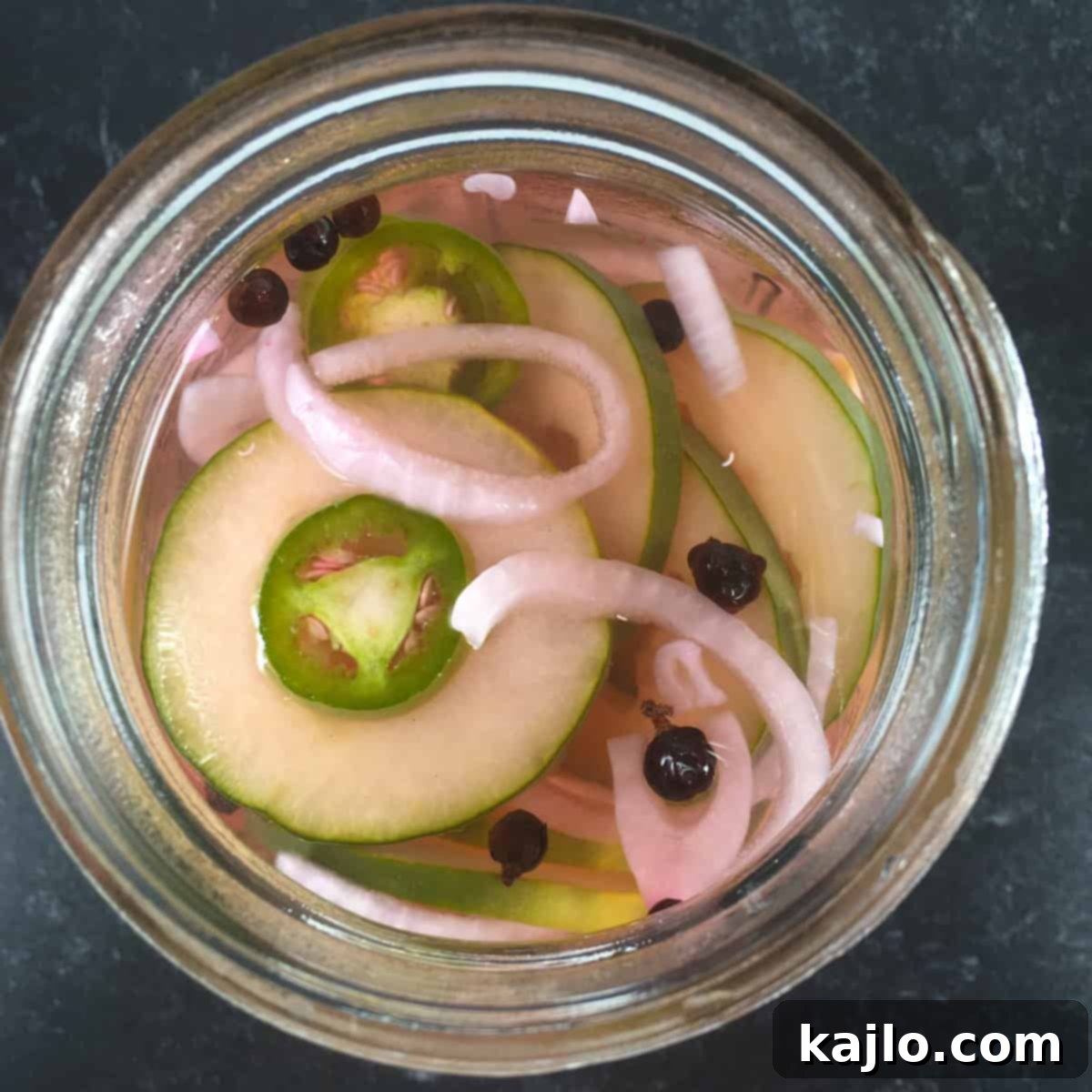
❓ Frequently Asked Questions (FAQs)
What kind of pickles have no sugar?
Dill pickles are inherently savory and are very commonly made without any added sugar during the pickling process. This makes them an excellent choice for individuals who are actively trying to limit sugar in their diet, including those on keto or low-carb diets. Always remember to check the nutrition label of store-bought pickle jars to ensure they are indeed sugar-free or “keto pickles,” as some brands may add sweeteners.
Do dill pickles need sugar?
No, authentic dill pickles do not require sugar in their traditional recipe. Their characteristic flavor comes from a brine composed of water, vinegar, salt, and various dill spices. Sugar is simply not a standard ingredient for classic dill pickles. Any sweetness in traditional dill pickles would typically come from the natural sugars present in the cucumbers themselves, which is negligible.
What is a good substitute for sugar in pickles?
For those who prefer a touch of sweetness in their pickles while avoiding real sugar, excellent substitutes include erythritol-based sweeteners like Swerve or monk fruit sweeteners such as Lakanto. These 1:1 sugar replacements can be easily incorporated into the brine to create delicious no-sugar versions of bread and butter pickles or other sweet pickle varieties, allowing you to control the sweetness without the carbohydrates.
Do you have to use sugar in pickling?
Using sugar in pickling is entirely optional and depends on the desired flavor profile. It is certainly not a mandatory ingredient. Many classic pickling recipes, particularly those for savory dill pickles, rely on vinegar, salt, and various spices for both flavor and preservation, without the addition of any sugar. Sugar is typically added to balance sharp acidic flavors or to create sweet or bread and butter style pickles. Therefore, whether you include sugar is purely a matter of personal preference and the specific type of pickle you aim to create.
Do you have to boil jars for refrigerator pickles?
No, for refrigerator pickles, there is no need to boil the jars for sterilization, as you would for traditional canning. Since these pickles are stored in the refrigerator and have a shorter shelf life, thorough cleaning is sufficient. Regularly washing your jars, either in the dishwasher on a hot cycle or by hand with hot, soapy water, is perfectly fine for preparing them for fridge pickles.
How long do refrigerator pickles last?
Homemade refrigerator pickles, when stored correctly, can last for 3-4 weeks in the refrigerator. It is essential that the cucumbers and other vegetables remain fully submerged in the brine throughout this period to ensure freshness and prevent spoilage. Freezing is not recommended for refrigerator pickles, as it will significantly alter their texture, typically making them mushy and unappetizing once thawed.
How to make refrigerator pickles no vinegar?
While most quick pickles rely on vinegar for their tang and preservation, you can indeed make refrigerator pickles without vinegar. This often involves a process similar to traditional fermentation using a salt brine, as demonstrated by culinary figures like Mark Bittman in his kosher pickles recipe. Keep in mind that these vinegar-free pickles will develop a different flavor profile, often more nuanced and less sharply acidic, relying on lactic acid fermentation for their characteristic sourness and preservation.

👩🏻🍳 Other Delicious Pickled & Fermented Recipes
If you’ve enjoyed making these easy refrigerator pickles and are keen to explore more fermented vegetables or fruit, you’ll love these other recipes:
- Fermented Red Cabbage Sauerkraut: A vibrant, gut-healthy classic.
- Lebanese Pickles Recipe: A unique, tangy blend often featuring beets and turnips.
- Fermented Lemons: A Moroccan staple, perfect for adding complex citrus notes to various dishes.
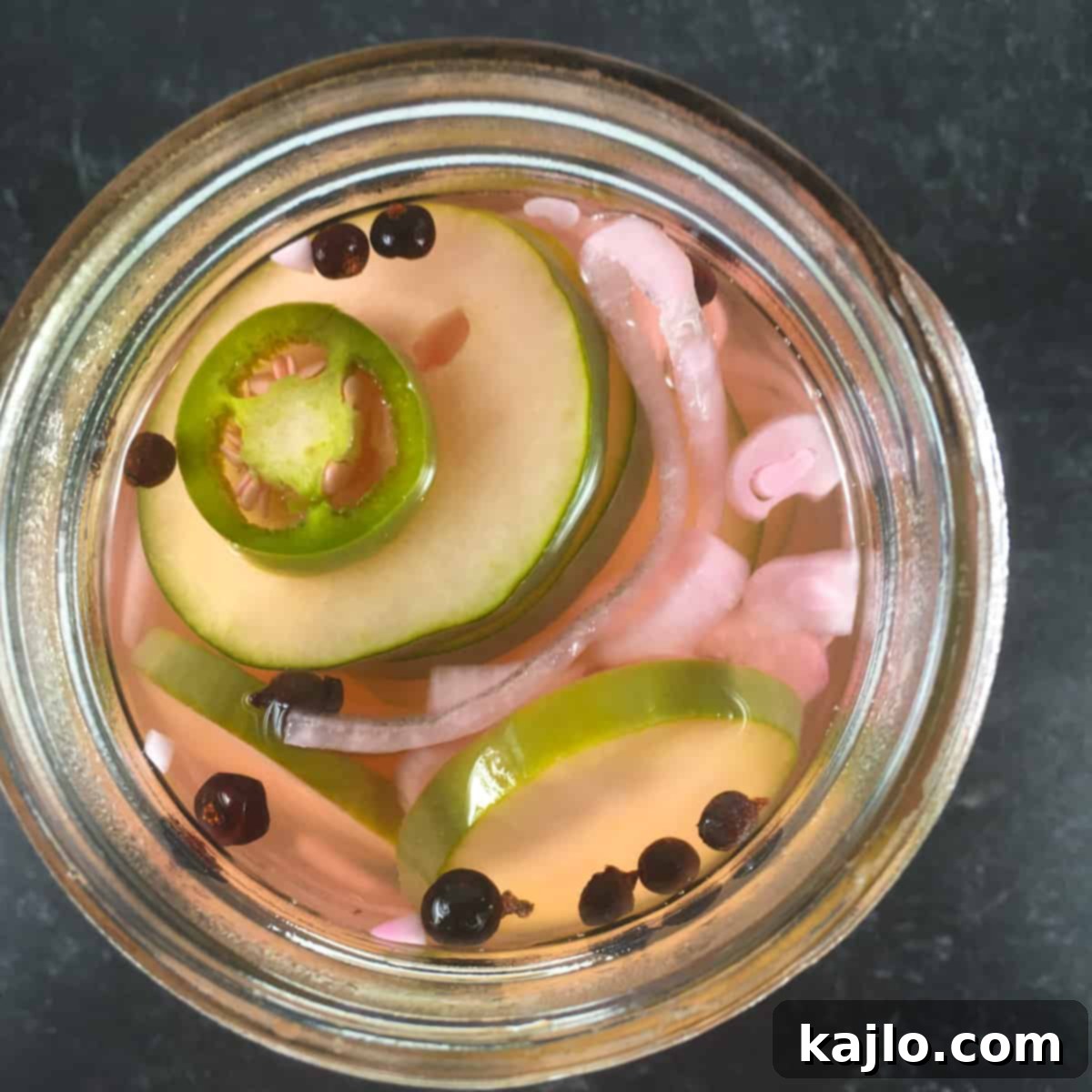
Watch How to Make It!

Refrigerator Dill Pickles No Sugar – Sugar-Free Refrigerated Pickles
Author: Summer Yule
Try my no-cook refrigerator pickles for a quick and effortless pickling recipe! Simply layer your herbs, onions, and cucumbers in a jar, pour over the brine, and refrigerate. It’s that easy!
Rating: 5 out of 5 stars (from 5 votes)
Prep Time: 10 minutes
Total Time: 10 minutes
Course: Side Dish, Slow Food DIY
Cuisine: American, Eastern European
Servings: 16
Calories: 5 kcal
Ingredients
Refrigerator Dill Pickles (No Sugar):
- 10 ounces pickling cucumbers, thinly sliced (284 grams; 1-2 cucumbers)
- 2-3 cloves garlic, smashed
- ½ medium onion, thinly sliced
- 4 sprigs fresh dill
- 1 cup white vinegar
- 3 cups water (very hot from tap)
- 1½ tablespoons finely ground sea salt
Pickle Recipe without Dill:
- 10 ounces pickling cucumbers, thinly sliced (284 grams; 1-2 cucumbers)
- 2-3 cloves garlic, smashed
- ½ medium red onion, thinly sliced
- ½ jalapeno, sliced
- 1 teaspoon brown mustard seeds
- 1 teaspoon juniper berries
- ½ teaspoon black pepper
- 1 bay leaf
- 1 cup white vinegar
- 3 cups water (very hot from tap)
- 1½ tablespoons finely ground sea salt
Love this recipe? Please leave a comment below 😊
Instructions
- Cut the cucumbers into slices that are ¼-inch (0.6 cm) thick, discarding the stem end. Cut the onion in half and slice ⅛-inch (0.3 cm) thick. Smash the garlic cloves.
- Stir the vinegar, hot water, and salt together until the salt has dissolved. Set this brine aside.
- Layer all of the other ingredients in a wide-mouth quart jar. I like to start with the herbs and spices and end with the cucumbers.
- Pour the brine over the top, filling the jar to the bottom of its neck and completely covering the cucumbers. You will not use all of the brine. Leave about 1-inch (2.54 cm) of headspace in the jar.
- Put the lid on the jar, give it a gentle shake, and refrigerate. These pickles are best after sitting in the fridge for around a week, but you can start enjoying them in 3-5 days if you’re feeling impatient. 🙂
Equipment
- Wide-Mouth Quart Jar
- Knife
Notes
💭 Expert Tips from Dietitian Summer Yule
This is a level 1 recipe (may help support fat loss). The nutrition information for this recipe excludes the brine. (Note: Though you are likely not consuming the brine, the sodium content of this recipe will be higher than listed below since the veggies do absorb some of the salt.)
Cucumber pickles with no added sugar, as we have here, are an extremely low-calorie food. They fit most special diets (aside from low-sodium diets), and they add a great flavor to meals. I enjoy them as a snack as well.
Cucumber pickles (though botanical fruits) count towards your non-starchy vegetable intake. Most of us in the U.S. don’t get enough veggies in our diets, so why not include some pickles?
The electrolyte losses associated with very low carb and keto diets can lead to electrolyte imbalances if the diet isn’t planned well. The salt in pickled and naturally fermented veggies can help replenish sodium. Though many of us overconsume sodium, it’s also an essential mineral that is needed for good health.
Most sodium in the American diet comes from ultra-processed foods and restaurant meals. If you are cooking at home and prioritizing whole foods, your diet may not be very high in sodium. Enjoying some cucumber pickles now and then is a good way to include more of this nutrient on healthy eating plans.
Nutrition information is for one serving of no sugar refrigerator dill pickles and does not include the brine, herbs, and spices. Sodium content is likely an underestimate, since some brine is absorbed by the veggies.
Nutrition Info Disclaimer
All recipes on this website may or may not be appropriate for you, depending on your medical needs and personal preferences. Consult with a registered dietitian or your physician if you need help determining the dietary pattern that may be best for you.
The nutrition information is an estimate provided as a courtesy. It will differ depending on the specific brands and ingredients that you use. Calorie information on food labels may be inaccurate, so please don’t sweat the numbers too much.
“To taste” means to your preferences, which may have to be visual to follow food safety rules. Please don’t eat undercooked food.
Nutrition
Carbohydrates: 1.1g
Protein: 0.2g
Sodium: 0.4mg
Potassium: 26mg
Fiber: 0.2g
Vitamin A: 0.4% DV
Vitamin C: 1.9% DV
Calcium: 0.2% DV
Iron: 0.2% DV
Keywords: fridge pickles no cook, fridge pickles no sugar, no boil pickles, no cook cucumber pickles, no cook fridge pickles, no cook refrigerator pickles, no sugar fridge pickles, no sugar refrigerator pickles, refrigerator dill pickles no sugar, refrigerator pickles no cook, refrigerator pickles no sugar
Shop our cookbook! Easy Air Fryer Recipes for One
Burning your air fryer recipes? Here’s how to fix it!
Join our community! Subscribe for all of the latest and greatest recipes, and follow me on Facebook, Pinterest, Instagram, and YouTube!
